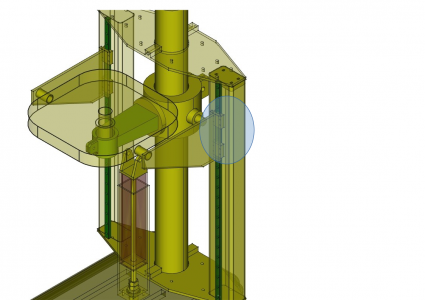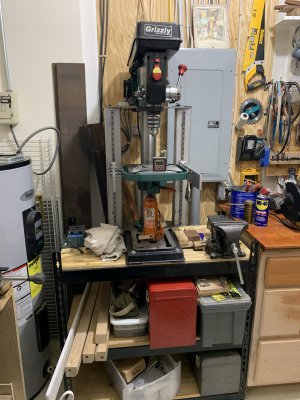I am modifying my drill press, so the table vertical movement can be moved accurately and not lose its XY reference.

I thought this would be a good project to get started and make something useful, and hopefully only use basic tools.
I'm retiring soon, so no new lathes or mills in my future.
The linear rails are attached to square tubing which in turn is secures by the top and bottom plates, I was able to get this far with a grinder, the DP and many hours with hack saw and file.
The part I'm stuck on is making the small plates that attach the cantilever arms to the linear bearings, these plates are 1-3/4" x 1-1/16" blocks. All the plate material is 3/8" aluminum plate. I cannot seem to cut these plates square, I have tried a few things:
1. Tried the miter saw, parts are too small to hold safely
2. Cut them over sized and then hand file them, (my eye hand coordination sucks, not even close)
3. Build a sliding track saw, but I cannot accurately square the blade to the fence (none of the corners are 90 deg.)
I ran out of ideas and was wondering if anyone here has some advice, I do own wood routers, but I wont even think of using these unless ia have a jig to hold the pieces safely. My last idea was to use a Jig to hold the parts vertical and at the correct angle and manually sand them on a flat surface (I do have a small 12"x12" machinist flat plate, I use it to sharpen chisels).
The Cantilever arms and the mounting plates are the only pieces that need to be square, everything else can be made to fit.
Thanks
Sal

I thought this would be a good project to get started and make something useful, and hopefully only use basic tools.
I'm retiring soon, so no new lathes or mills in my future.
The linear rails are attached to square tubing which in turn is secures by the top and bottom plates, I was able to get this far with a grinder, the DP and many hours with hack saw and file.
The part I'm stuck on is making the small plates that attach the cantilever arms to the linear bearings, these plates are 1-3/4" x 1-1/16" blocks. All the plate material is 3/8" aluminum plate. I cannot seem to cut these plates square, I have tried a few things:
1. Tried the miter saw, parts are too small to hold safely
2. Cut them over sized and then hand file them, (my eye hand coordination sucks, not even close)
3. Build a sliding track saw, but I cannot accurately square the blade to the fence (none of the corners are 90 deg.)
I ran out of ideas and was wondering if anyone here has some advice, I do own wood routers, but I wont even think of using these unless ia have a jig to hold the pieces safely. My last idea was to use a Jig to hold the parts vertical and at the correct angle and manually sand them on a flat surface (I do have a small 12"x12" machinist flat plate, I use it to sharpen chisels).
The Cantilever arms and the mounting plates are the only pieces that need to be square, everything else can be made to fit.
Thanks
Sal


